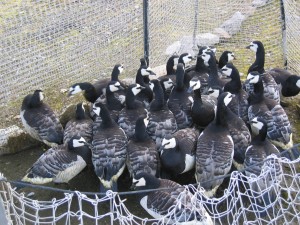|
Goose counting 5 August 2004 |
A personal photo report from
Maarten Loonen |
 |
During our stay, we count the geese in the village twice a day and outside the village once every 4 days. During this counting, we check all ringed individuals.
For every ringed individual, we note the pairbond, the number of goslings and the moult stage. In this way we are building individual histories about what happened with a goose in this summer.
Family groups always leave the safest places close to the water and forage on tundra and grass areas. In 2004, most nests were predated by polar foxes and a polar bear. Also in the village, predation is high. Under one of the houses is a polar fox den with 6 puppies. |
 |
Goose catching 6 August 2004
 |
Catching, measuring and ringing geese is an important annual part of our study. Today, we are catching the family group. The goslings are big enough to be ringed. A group of university students from UNIS is joining the catch. The night before they have made
behavioural observations on the geese and now they learn more about goose research.
The geese cannot fly, because they are moulting. With a group of people we round them into a pen. After the catch, we wait for 2 hours so the gut is emptied. Then the geese are ringed, sexed, weighed and measured. Sexing geese is possible by cloacal examination. I measure the tarsus (=leg), ninth primary (longest flight feather), midwing and head from tip of bill to the back. The students weigh the birds and place them back in the pen. At the end of the catch, the families are re-united and released to a pond. There were 15 goslings left in this group and it is the only family group which visits town. Most families arriving in town have been predated by polar foxes. A short video on measuring geese can be seen here.  |
 |
 |
 |
Vegetation studies 7 August 2004
 |
 |
 |
| Measuring vegetation cover by point quadrating. Click here for video. | During vegetation measurement these geese came extremely close | Jurjen Annen estimates vegetation cover and clips above-moss biomass of monocotyls |
 |
To the left, you can see one of my exclosures, which is a beautiful example of the effect of grazing and grass-moss interaction.
The exclosed half on the background was built in 1991. In 1997 a second exclosure was built next to the old one.
In 2000, both exclosures were halved. The area to the right on the picture was re-opened for grazing again.
The exclosure shows that there are a lot of gras in the grazed moss carpet.
After exclosing, these shoots produce a dense carpet and flower in two years time.
But being ungrazed, also the moss starts to build-up. It becommes fluffy and thicker.
In early spring, the thick moss carpet is an insulating layer for the permafrost thawing.
The moss itself has no problem with this because it grows on the surface. The grasses however, are rooted in
the moss carpet and stay frozen for two-to three weeks longer.
The competitive ability between the moss and grass is changed by exclosing grazing. On the long run grasses will disappear.
No grass without grazing. |
|
 |
 |
 |
| Grazed, short clipped grasses, few dicotyls | Exclosed since 1997, much grass | Exclosed since 1991, grass disappearing |
Kittiwake behaviour and hormones 8 August 2004
 |
Today, I went with my French collegae Olivier Chastell to the Kittiwake cliff 7 kilometer east of Ny-Ålesund. Here, kittiwakes nests are reachable with a ladder. Kittiwakes are caught, ringed and measured. Blood is taken to analyse hormone levels. Olivier is interested in the role of hormones in regulating parental behaviour. |  |
|